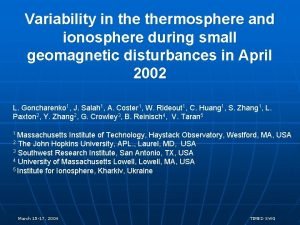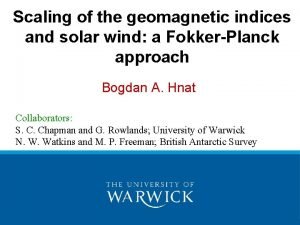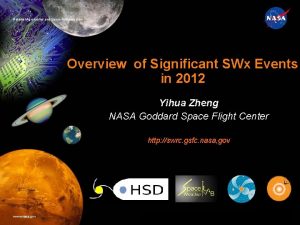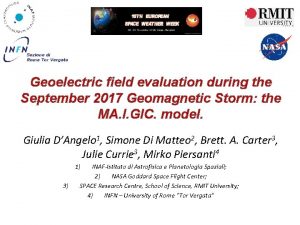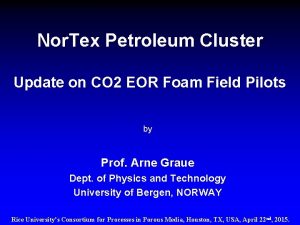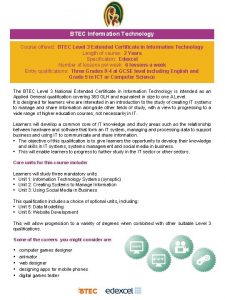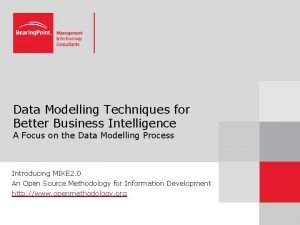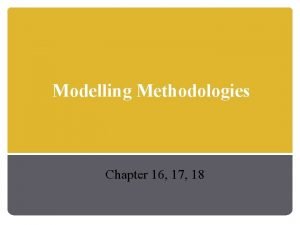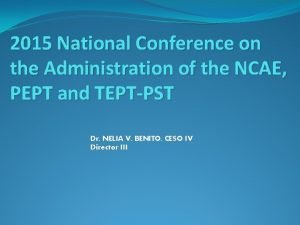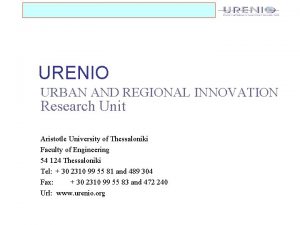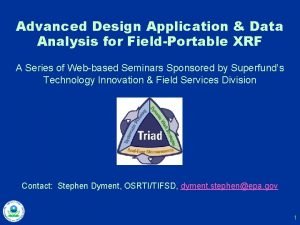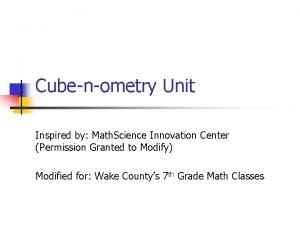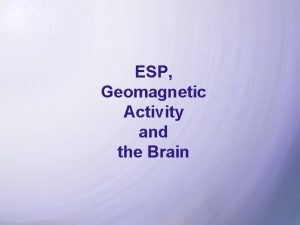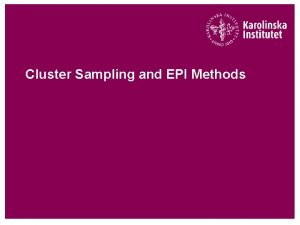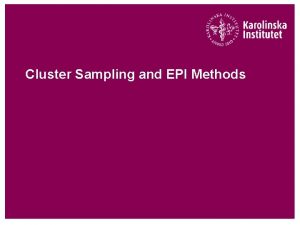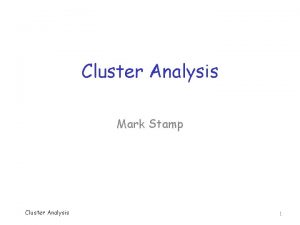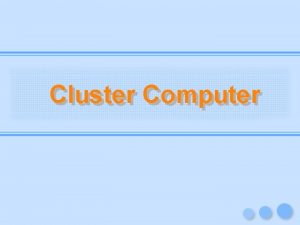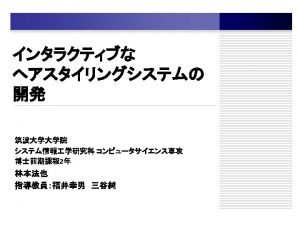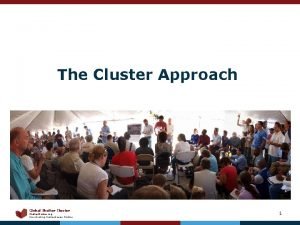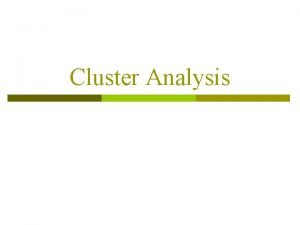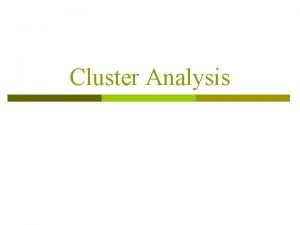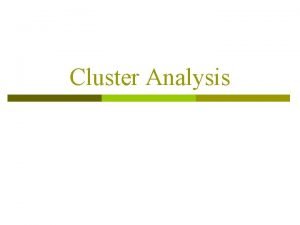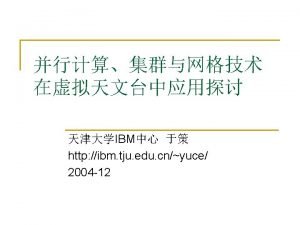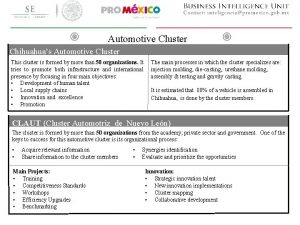Data Innovation and Science Cluster Geomagnetic Field Modelling


















- Slides: 18

Data, Innovation, and Science Cluster Geomagnetic Field Modelling Using Multi-Mission Data Sets Nils Olsen (DTU Space) with contributions from Tiku Ravat, Chris Finlay, Lars Tøffner-Clausen, Mike Purucker • Update on LCS-1 Lithospheric Field Model • Towards interpretation of LCS-1: estimation of depth-integrated magnetic susceptibility 7 th Swarm Data Quality Workshop 24– 27 October 2017 Delft/ NL

LCS-1 Lithospheric Field Model Lithospheric Model from CHAMP and Swarm – Version 1 • Swarm data (only Alpha and Charlie), Nov 2013 – Dec 2016 (3 years) CHAMP data, Oct 2006 – Sept 2010 (4 years) • Only “gradient” data (finite spatial differences) • NS-gradient approximated by along-track first differences of 15 sec data, CHAMP + Swarm • EW-gradient approximated by difference Swarm Alpha – Swarm Charlie (at same latitude) • Removal of CHAOS-6 core field (n=1 -15) and large-scale magnetospheric field • Data misfit regularization: Robust (Tukey) weighting • Model regularization: Minimization of |Z | averaged over Earth’s surface (ellipsoid) • Model parameterization: 35 000 point sources at 100 km depth transformation to spherical harmonic expansion, formally up to degree n=185 Olsen et al, GJI, 2017 7 th Swarm Data Quality Workshop 24– 27 October 2017 Delft/ NL

Z at Earth’s surface (ellipsoid) Model regularization parameter a 2 = 3 7 th Swarm Data Quality Workshop 24– 27 October 2017 Delft/ NL

Adding 8 months Swarm data (Jan – Aug 2017) a 2 = 3 (should be larger since more data are added) 7 th Swarm Data Quality Workshop 24– 27 October 2017 Delft/ NL

Adding 8 months Swarm data (Jan – Aug 2017) Waiting for more Swarm data … … obtained at lower altitudes a 2 = 4 7 th Swarm Data Quality Workshop 24– 27 October 2017 Delft/ NL

LCS-1 Lithospheric Field Model • Swarm data (only Alpha and Charlie), Nov 2013 – Dec 2016 (3 years) CHAMP data, Oct 2006 – Sept 2010 (4 years) • Only “gradient” data (finite spatial differences) • NS-gradient approximated by along-track first differences of 15 sec data, CHAMP + Swarm • EW-gradient approximated by difference Swarm Alpha – Swarm Charlie (at same latitude) • Removal of CHAOS-6 core field (n=1 -15) and large-scale magnetospheric field • Data misfit regularization: Robust (Tukey) weighting • Model regularization: Minimization of |Z | averaged over Earth’s surface (ellipsoid) • Model parameterization: 35 000 point sources at 100 km depth transformation to spherical harmonic expansion, formally up to degree n=185 • Alternative Model parameterization: spherical harmonics up to n=185, using same data set and model regularization Olsen et al, GJI, 2017 7 th Swarm Data Quality Workshop 24– 27 October 2017 Delft/ NL

Z at Earth’s surface (ellipsoid) Based on SH expansion a 2 = 3 7 th Swarm Data Quality Workshop 24– 27 October 2017 Delft/ NL

Z at Earth’s surface (ellipsoid) Based on point source expansion a 2 = 3 7 th Swarm Data Quality Workshop 24– 27 October 2017 Delft/ NL

Spatial Powerspectra Shape of spectra is determined by model regularization, not by choice of basis functions (point sources vs. spherical harmonics) - for “reasonable” values of regularization 7 th Swarm Data Quality Workshop 24– 27 October 2017 Delft/ NL

Conclusions 1 • LCS-1 lithospheric maps and powerspectra are determined by • Data selection (only “gradient data”) and robust data processing • model regularization (L 1 regularisation of |Z |) • … but not by choice of basis functions (point sources vs. spherical harmonics) • Advantage of point source representation: • Faster accumulation of normal matrices for point sources (code optimization? ) • Point sources allow for higher spatial resolution in regions with better data coverage (e. g. joint analysis of satellite and regional aeromagnetic data – not done for LCS-1 model) 7 th Swarm Data Quality Workshop 24– 27 October 2017 Delft/ NL

Outlook: Depth-integrated susceptibility (crustal thickness) constrained by LCS-1 • Depth integrated susceptibility • Inducing magnetic field B 0 (given by CHAOS-6 core field model) • Linear relationship between Gauss coefficients g of lithospheric field caused by induced magnetization and depth-integrated susceptibility (at global equal-area grid): • Crustal thickness h from model crust 1. 0 (Laske et al) • A-priori value of magnetic susceptibility c = 0. 04 SI (assumed to be constant) 7 th Swarm Data Quality Workshop 24– 27 October 2017 Delft/ NL

Depth-integrated susceptibility from crust 1. 0 7 th Swarm Data Quality Workshop Resulting magnetic field Br at surface 24– 27 October 2017 Delft/ NL

Solving the inverse problem • Forward problem • Inverse problem with “generalized matrix inverse” G–g • Without additional information this is an unsolvable problem due to existence of “annihilators” (distribution of k that do not produce any magnetic field) e. g. a spherical shell of constant k (Runcorn’s theorem) • A-priori information is needed, e. g. from crust 1. 0 • Estimation of depth-integrated susceptibility k by constrained Least-Squares inversion of LCS-1 Gauss coefficients for SH degrees n = 16 - 160 regularization parameter a 2, a-priori solution k 0 7 th Swarm Data Quality Workshop 24– 27 October 2017 Delft/ NL

Br at surface (n=16 – 160) r LCS-1 7 th Swarm Data Quality Workshop 24– 27 October 2017 Delft/ NL

Br at surface (n=16 – 160) r … as predicted by “optimized” model of k 7 th Swarm Data Quality Workshop 24– 27 October 2017 Delft/ NL

Depth-integrated susceptibility from LCS-1 and crust 1. 0 - the “optimized” model of k Note: this model is only valid in regions where induced magnetization dominates remnant magnetisation 7 th Swarm Data Quality Workshop 24– 27 October 2017 Delft/ NL

Spectral powerspectra 7 th Swarm Data Quality Workshop 24– 27 October 2017 Delft/ NL

Conclusions • LCS-1 lithospheric maps and powerspectra are determined by • Data selection (only “gradient data”) and robust data processing • model regularization (L 1 regularisation of |Z |) • … but not by choice of basis functions (point sources vs. spherical harmonics) • New method to determine depth-integrated susceptibility from Gauss coefficients of lithospheric field model and a-priori information • Model of depth-integrated susceptibility derived which explains > 99% of LCS-1 spatial power (Note: this model is only valid in regions where induced magnetization dominates) 7 th Swarm Data Quality Workshop 24– 27 October 2017 Delft/ NL
 Geomagnetic
Geomagnetic Building statistics
Building statistics Geomagnetic
Geomagnetic Geomagnetic
Geomagnetic Maritime innovation cluster
Maritime innovation cluster Mysite.socccd
Mysite.socccd Radical innovation vs disruptive innovation
Radical innovation vs disruptive innovation Nortex data science cluster
Nortex data science cluster Trendlines and regression analysis
Trendlines and regression analysis Unit 5 data modelling assignment 2
Unit 5 data modelling assignment 2 Data modelling techniques in business intelligence
Data modelling techniques in business intelligence Data modelling methodologies
Data modelling methodologies Power platform data modelling
Power platform data modelling Data modeling concepts
Data modeling concepts Grade 9 ncae results sample
Grade 9 ncae results sample Innovation field
Innovation field Innovation field
Innovation field Favorite subject is science
Favorite subject is science Math and science innovation center
Math and science innovation center
